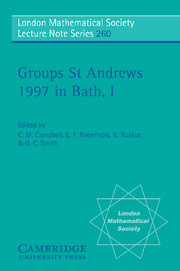Book contents
- Frontmatter
- Contents
- Contents of Volume II
- Introduction
- Radical rings and products of groups
- Homogeneous integral table algebras of degrees two, three and four with a faithful element
- A polynomial-time theory of black box groups I
- Totally and mutually permutable products of finite groups
- Ends and algebraic directions of pseudogroups
- On locally nilpotent groups with the minimal condition on centralizers
- Infinite groups in projective and symplectic geometry
- Non-positive curvature in group theory
- Group-theoretic applications of non-commutative toric geometry
- Theorems of Kegel-Wielandt type
- Singly generated radicals associated with varieties of groups
- The word problem in groups of cohomological dimension
- Polycyclic-by-finite groups: from affine to polynomial structures
- On groups with rank restrictions on subgroups
- On distances of multiplication tables of groups
- The Dade conjecture for the McLaughlin group
- Automorphism groups of certain non-quasiprimitive almost simple graphs
- Subgroups of the upper-triangular matrix group with maximal derived length and a minimal number of generators
- On p-pronormal subgroups of finite p-soluble groups
- On the system of defining relations and the Schur multiplier of periodic groups generated by finite automata
- On the dimension of groups acting on buildings
- Dade's conjecture for the simple Higman-Sims group
- On the F*-theorem
- Covering numbers for groups
- Characterizing subnormally closed formations
- Symmetric words in a free nilpotent group of class 5
- A non-residually finite square of finite groups
Group-theoretic applications of non-commutative toric geometry
Published online by Cambridge University Press: 05 August 2013
- Frontmatter
- Contents
- Contents of Volume II
- Introduction
- Radical rings and products of groups
- Homogeneous integral table algebras of degrees two, three and four with a faithful element
- A polynomial-time theory of black box groups I
- Totally and mutually permutable products of finite groups
- Ends and algebraic directions of pseudogroups
- On locally nilpotent groups with the minimal condition on centralizers
- Infinite groups in projective and symplectic geometry
- Non-positive curvature in group theory
- Group-theoretic applications of non-commutative toric geometry
- Theorems of Kegel-Wielandt type
- Singly generated radicals associated with varieties of groups
- The word problem in groups of cohomological dimension
- Polycyclic-by-finite groups: from affine to polynomial structures
- On groups with rank restrictions on subgroups
- On distances of multiplication tables of groups
- The Dade conjecture for the McLaughlin group
- Automorphism groups of certain non-quasiprimitive almost simple graphs
- Subgroups of the upper-triangular matrix group with maximal derived length and a minimal number of generators
- On p-pronormal subgroups of finite p-soluble groups
- On the system of defining relations and the Schur multiplier of periodic groups generated by finite automata
- On the dimension of groups acting on buildings
- Dade's conjecture for the simple Higman-Sims group
- On the F*-theorem
- Covering numbers for groups
- Characterizing subnormally closed formations
- Symmetric words in a free nilpotent group of class 5
- A non-residually finite square of finite groups
Summary
Introduction
These lectures consider the way some geometric techniques can be used to approach questions about ‘small’ groups, in particular, their finite present ability and the structure of their automorphism groups. By a ‘small’ group I mean one containing no non-Abelian free subgroups. Most of the time this will be in the context of discrete groups but towards the end I shall observe that one can glean related information using counting methods in the world of pro-p groups. The common theme is that a small group is in some sense at most half the size of a free group. The geometric and pro-p approaches give different ways of making this latter statement more precise. Both techniques involve looking only at the residually finite images of the group; there is no information to be had in this way about infinite simple groups for example. At the other extreme, finite groups also do not register on the scale.
In fact we shall be looking at various aspects of the representation theory of the group and consequently group rings come into play. However, rather than concentrating on group rings, I shall try and convince you that some non-commutative relatives of familiar commutative Noetherian rings are worth studying and that their representation theory has applications in group theory.
- Type
- Chapter
- Information
- Groups St Andrews 1997 in Bath , pp. 176 - 194Publisher: Cambridge University PressPrint publication year: 1999
- 1
- Cited by



